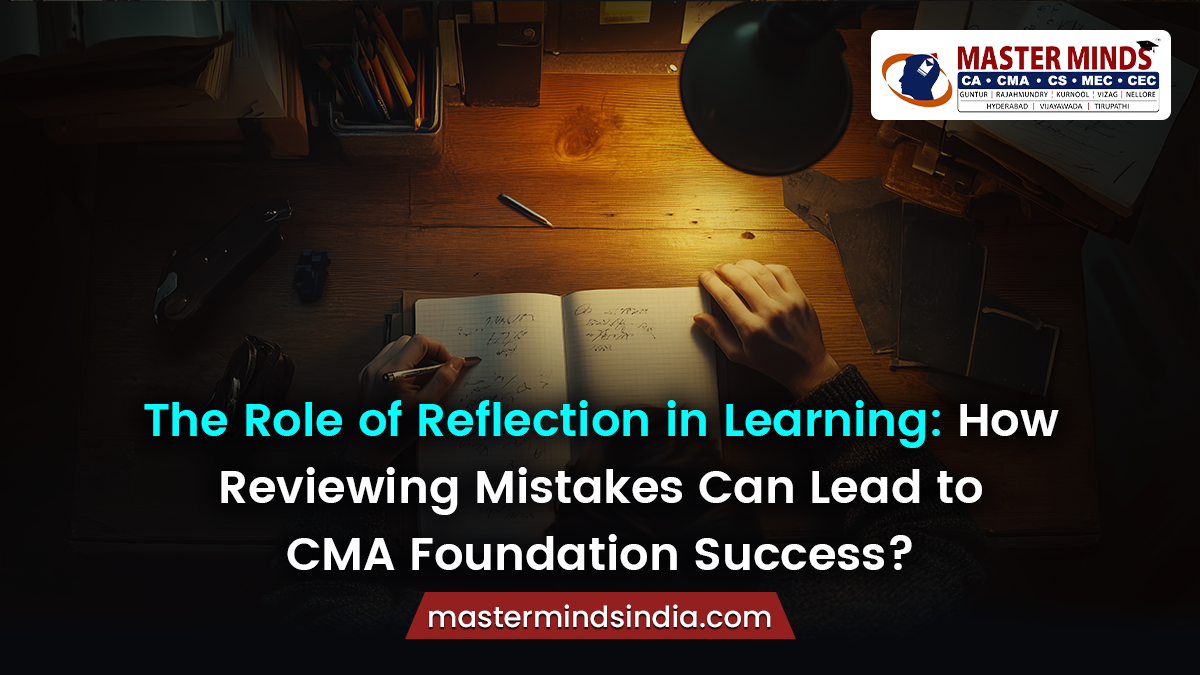The Role of Reflection in Learning: How Reviewing Mistakes Can Lead to CMA Foundation Success?

Failure is not the opposite of success it is part of it. Studies show that students who review their mistakes can improve learning by up to 50%, which is a big advantage for CMA Foundation aspirants. However, many students avoid their mistakes because they feel uncomfortable. But reflecting on errors can turn failures into opportunities for growth.
By analyzing mistakes, finding patterns, and improving study methods, you can learn smarter and build a strong mindset. In this article, we will explore how reviewing mistakes can help you succeed in the CMA Foundation exam with simple techniques and real examples.
Why Reviewing Mistakes Matters?
Insight: Reflection is a cornerstone of effective learning. It enables you to gain deeper insights into your performance, understand the root causes of errors, and implement strategies for improvement.
Key Points:
- Identifying Patterns: Reviewing mistakes helps in identifying recurring patterns and common errors, which provides clarity on areas that need more focus.
- Understanding Concepts: Reflecting on errors deepens your understanding of complex concepts, as you analyze what went wrong and how to correct it.
Action Steps:
- Regular Reflection Sessions: Set aside dedicated time to review and analyze mistakes after practice tests or study sessions.
- Document Errors: Maintain a journal or log of mistakes, including details about the error and your thoughts on why it happened.
Example: A student who regularly reviews mistakes in practice tests is likely to spot recurring themes, such as misinterpretation of questions or calculation errors, leading to more targeted study and improved performance.
Effective Strategies for Reviewing Mistakes
Insight: To maximize the benefits of reflection, it’s essential to employ structured strategies that enable you to gain actionable insights and make meaningful improvements.
Key Points:
- Detailed Analysis: Break down each mistake to understand its root cause whether it was due to lack of knowledge, misinterpretation, or time management issues.
- Solution-Focused Approach: Focus on finding solutions and creating strategies to avoid similar errors in the future.
Action Steps:
- Post-Test Reviews: After each practice test, spend time reviewing incorrect answers. Analyze why you made each mistake and how you can rectify it.
- Seek Feedback: Discuss your errors with mentors or peers to gain different perspectives and solutions.
Example: A student might discover that their mistakes in numerical problems stem from rushing through calculations. By focusing on practicing calculations with precision and patience, they can reduce errors in future tests.
Lessons from Mistakes
Insight: Mistakes are not failures but growth opportunities. Embracing this mindset can transform your approach to learning and enhance your exam preparation.
Key Points:
- Growth Mindset: Viewing mistakes as opportunities for growth helps build resilience and a positive attitude towards learning.
- Learning Opportunities: Each error provides a chance to reinforce understanding and improve skills.
Action Steps:
- Reflect on Successes: Alongside reviewing mistakes, acknowledge and reflect on your successes to build confidence and recognize effective strategies.
- Incorporate Learnings: Apply insights gained from mistakes to future study sessions and exams.
Example: A student who initially struggled with complex problems but reflected on their mistakes and adjusted their study approach might eventually excel in handling similar questions in the actual exam.
You Can Also Read:
- CA Intermediate New Study Material
- CA Course Duration After 10th, 12th & Graduation
- Tips to Crack CA in First Attempt
- Time-Saving Calculator Tricks for CA Foundation Students
- How to become a CA?
- CA Foundation New Syllabus
- CA Inter New Syllabus
- ICAI CA New Scheme
Developing a Reflective Practice Routine
Insight: Establishing a routine for reflection ensures that it becomes a consistent and integral part of your study process.
Key Points:
- Scheduled Reviews: Incorporate reflection sessions into your study schedule, making them a regular part of your preparation.
- Feedback Mechanisms: Use self-assessment tools and seek feedback from mentors to enhance your reflective practice.
Action Steps:
- Weekly Reflection Sessions: Dedicate time each week to review mistakes, analyze progress, and adjust your study strategies.
- Create Reflection Prompts: Use prompts or questions to guide your reflection, such as “What went wrong?” and “How can I improve?”
Example: Setting a weekly review session allows students to systematically address and learn from mistakes, making incremental improvements in their preparation.
Embracing Challenges
Insight: Reflection fosters resilience by helping you embrace challenges and setbacks as part of the learning process. It builds a mindset that views difficulties as opportunities to grow.
Key Points:
- Resilient Attitude: Embrace challenges with a positive mindset, understanding that each mistake brings you closer to success.
- Continuous Improvement: Use reflection to continuously refine your skills and strategies, enhancing your overall performance.
Action Steps:
- Maintain a Positive Outlook: Approach mistakes with curiosity and a desire to improve rather than frustration or defeat.
- Celebrate Progress: Recognize and celebrate improvements and successes resulting from reflective practice.
Example: A student who encounters challenges but uses reflection to adapt and improve is likely to develop a resilient attitude, leading to sustained progress and success.
CA & CMA Online Classes:

